Using Restore and Renew webtools to guide restoration
A new research project by the Research Centre for Ecosystem Resilience (ReCER) is exploring how genomic information can guide the restoration of threatened ecological communities.
This is part three of a three-part series on using conservation genomics to help restore threatened ecological communities.
In part one, we describe why genetics is relevant to ecological restoration. In part two we outline how restoration practitioners can use the Restore and Renew webtools to consider genetic information and climate change when sourcing material for restoration. And in this final part, we highlight how a new study is using the Restore and Renew webtools to help guide the restoration of Cumberland Plain Woodland, and ultimately, other threatened ecological communities.
Key points
- The availability of suitable genetically diverse ‘climate ready’ material is a major constraint to the effective restoration of threatened ecological communities.
- Sampling from further afield and Seed Production Areas can increase available material—but should be guided by genetic data rather than generalisations to avoid negative consequences.
- A new project is using genomic information to guide seed sourcing for restoration of the threatened ecological community Cumberland Plain Woodland.
- Research outcomes will help expand application of the Restore and Renew webtools from a species-by-species approach to regional scale or community-specific restoration guidelines that will help practitioners maximise the self-sustainability, overall resilience and climate readiness of restored populations, while optimising return of investment.
Ecological restoration is a necessary tool in the conservation of threatened ecological communities
More than 100 ecological communities are at risk of becoming extinct across NSW and hundreds more nationally. Many of these threatened ecological communities occur as small, degraded and isolated remnants and are dependent on effective restoration to persist.
A new research project by the Research Centre for Ecosystem Resilience (ReCER) is exploring how genomic information can guide the restoration of threatened ecological communities and will help expand the application of the Restore and Renew webtools from a species-by-species approach to regional scale or community-specific restoration guidelines.
Sourcing suitable genetically diverse ‘climate ready’ material is challenging
A major constraint in effective restoration of threatened ecological communities is the availability of suitable genetically diverse ‘climate ready’ material.
The availability of suitable seed and other propagule material may be limited by:
- few remnants to collect from,
- being unable to collect from some remnants due to their reserve status and/or because seed collection may further threaten their viability, and by
- low levels of genetic diversity due to habitat loss and increased fragmentation.
Guiding restoration of threatened ecological communities
Sourcing material from further afield can help overcome these limitations. Given the extent of habitat loss and our changing climate, limiting ourselves to collecting only local provenance material may no longer be adequate, particularly when it comes to restoring threatened ecological communities. Sampling further afield, can increase genetic diversity and ensure restored communities are future-adapted and climate-ready, but needs to be guided by genetic data rather than generalisations to avoid negative consequences such as hybridisation, or genetic swamping of natural populations and disruption of local adaptation.
The establishment of Seed Production Areas can also be used to increase seed availability. However, this too should be guided by genetic information when used to produce material for restoration of threatened ecological communities, as any limitations (for example, low genetic diversity) can be amplified throughout propagation.
The Restore and Renew webtools make conservation genomic and climatic information freely available to restoration practitioners and can help to guide decisions regarding where to sensibly source ‘climate ready’ genetically diverse seed for restoration and for use in the establishment of Seed Production Areas.
Can we collect material for one ecological community from another?
A common question from practitioners striving to source sufficient genetically diverse material when restoring a threatened ecological community, is whether they should collect only from the same community being restored, or whether they can collect material from other ecological communities.
A new project by the Research Centre for Ecosystem Resilience (ReCER), part of the Australian Institute for Botanical Science, is exploring this question and others and will help to expand the application of the Restore and Renew webtools from a species-by-species approach to regional scale or community-specific restoration guidelines.
Using the Restore and Renew webtools to guide restoration of Cumberland Plain Woodland
When a plant looks at a landscape it does not see communities as we define them, it sees patterns of resource availability and different suitability of habitat,” says Dr Patrick Fahey, leading the new threatened ecological community restoration research project from Research Centre for Ecosystem Resilience (ReCER).
“We are investigating whether these community definitions matter to the plants within them or are they responding to different things individually at the species level. And therefore, does it matter whether you source your seed from a patch of Cumberland Plain Woodland or a patch of Shale Sandstone Transition Forest, for example.”
“We are working on approximately twenty species which occur in Cumberland Plain Woodland, a threatened ecological community which only occurs in the Sydney Basin Bioregion.”
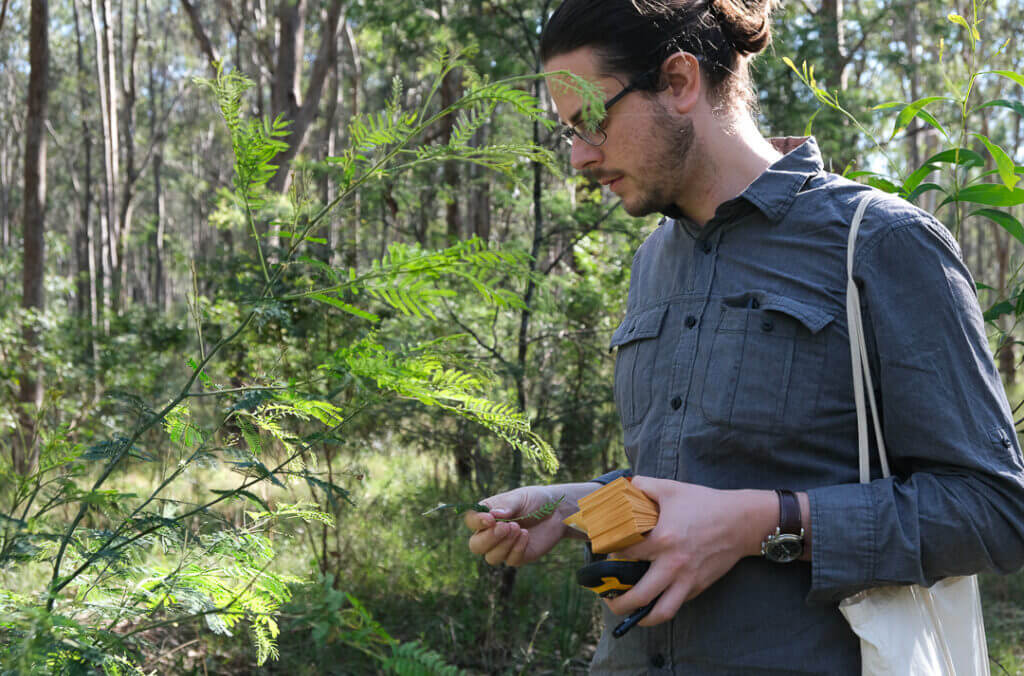
Dr Patrick Fahey with Research Centre for Ecosystem Resilience (ReCER) has been out and about collecting leaf material (here Acacia parvipinnula) from across the Cumberland Plain and further afield into the Hunter Valley and North Coast.
Today, only nine per cent of the original extent of Cumberland Plain Woodland remains intact, with remnants scattered widely across the Cumberland Plain. Given the extent of habitat loss and fragmentation, plant populations within these remnants may have lost genetic diversity due to a reduction in population size and increased isolation, and consequently seed sourced from these remnants may lack sufficient diversity and resilience.
“We are exploring how important an ecological community definition is genetically. For example, does collecting from one ecological community, for restoration of another, change patterns of genetic diversity or influence restoration success?” says Dr Fahey.
“By selecting species which co-occur in the one community, and are therefore probably experiencing the same pressures, we can also look at patterns across these species and see if we can make generalisations for restoration practitioners. For example, do you have to consider where you are getting seed from for each individual species separately, or are there some overarching patterns you can look at when you are sourcing seed for a particular community or a particular site?”
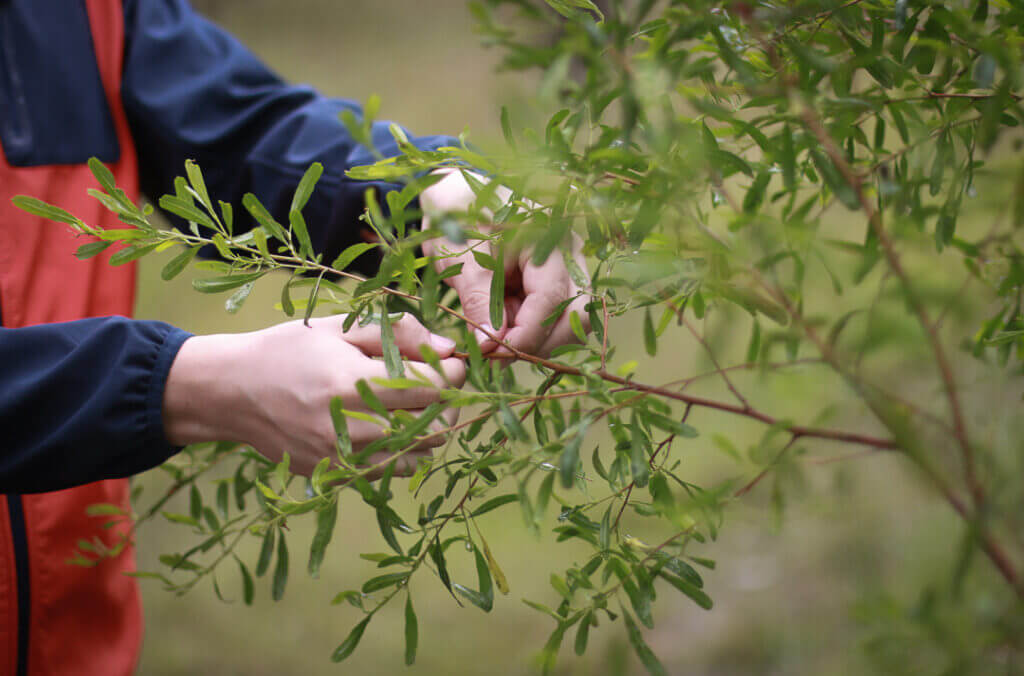
Sampling leaf material from sticky hop bush, a species that occurs in Cumberland Plain Woodland and other ecological communities across NSW and beyond.
“We have selected species that occur in Cumberland Plain Woodland and further afield. For example, Eucalyptus fibrosa, Dodonaea viscosa, Bursaria spinosa, Pimelea linifolia, and Themeda triandra. These are all widespread common species that are commonly used in restoration, or have potential to be used in restoration. We have included species with different life histories, everything from trees to grasses,” says Dr Fahey.
Using cutting edge technology
Research Centre for Ecosystem Resilience (ReCER) are using Next-generation Sequencing (NGS), a technique similar to that used in the ‘Human genome project’ to collect genetic information on a vast scale.
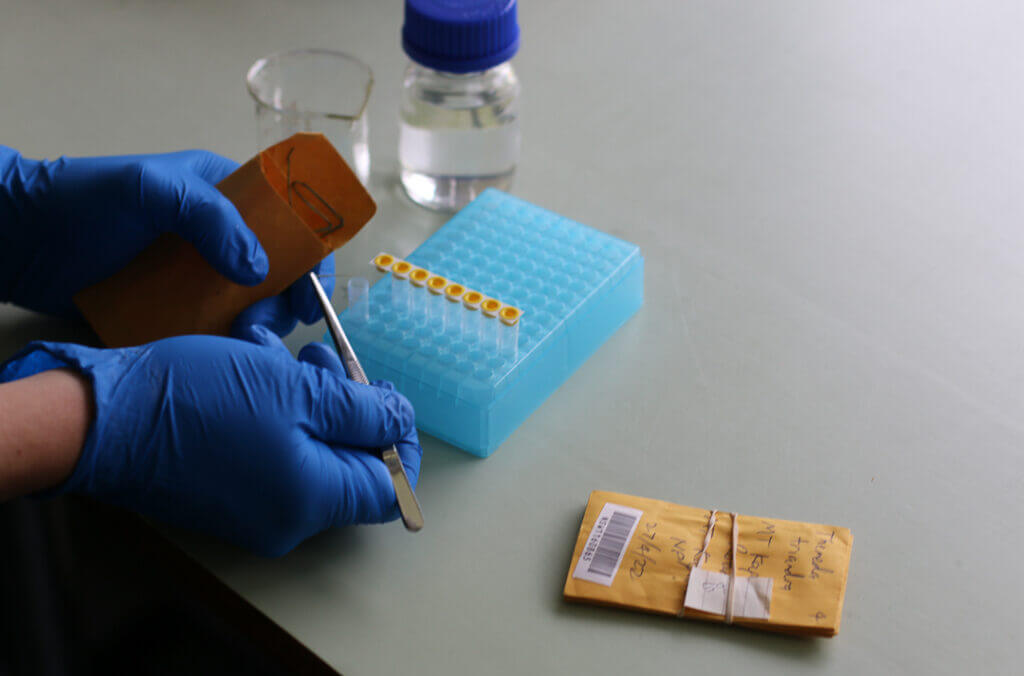
From a single leaf a wealth of information can be obtained using Next-generation Sequencing.
“The process has become incredibly streamlined, the most time-consuming part is almost always going out and finding the plant to collect the leaf from. Once we have the leaf it is a relatively straightforward process these days,” says Dr Fahey.
“We put the leaf in a small envelope with a barcode on it and collect metadata using the AIBS Field Collection App. The metadata and barcode stay with each specimen throughout the entire process. Once that leaf is in the envelope, we bring it back to the herbarium as soon as possible where it is frozen to -80 degrees, and then freeze dried. This is to dry the sample as quickly as possible to preserve the DNA, as water will damage DNA.”
“The DNA extraction and sequencing is done by a commercial laboratory and is incredibly streamlined, allowing us to handle thousands of samples. Data can be very quickly generated and returned to us for analysis.”
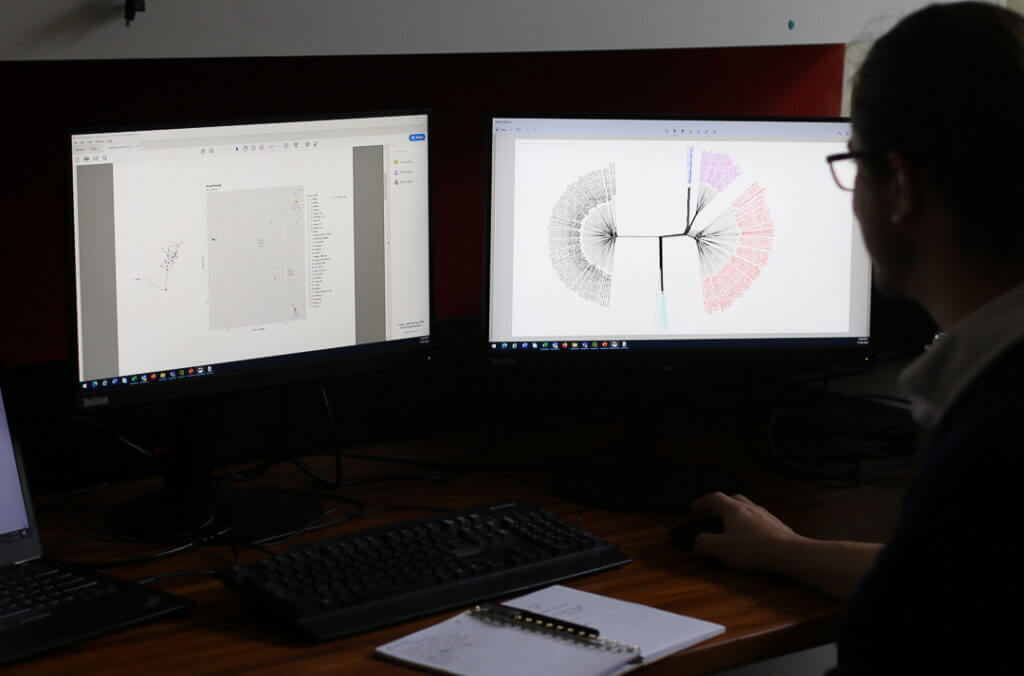
Research Centre for Ecosystem Resilience (ReCER) has developed a streamlined workflow, that is cost and time effective, enabling analysis of patterns of genetic diversity for hundreds of plant species commonly used in restoration.
“We use a reduced representation libraries sequencing method which allows us to look for genetic differences across the entire genome. We can detect thousands of sites in the genome that differ between our samples, which far exceeds that found using techniques available twenty years ago, such as allozyme or microsattelites studies, which could detect tens to hundreds of different sites.”
“This increased volume of data allows us to detect finer scale genetic patterns across the landscape and be more confident that we are limiting biases that may affect our findings.”
Making research outcomes available to restoration practitioners
Results will be freely available in the Restore and Renew webtools and can be used by practitioners to guide their seed collection for restoration and for establishment of seed production areas so as to maximise self-sustainability, overall resilience and climate readiness of planted populations, while optimising return of investment.
“If someone is trying to restore a patch of Cumberland Plain Woodland, they will be able to use the Restore and Renew webtools to guide their seed sourcing to maximise resilience. For example, if there are no seed sources within 5-10km of their restoration site, they can use the webtools to investigate whether going to a patch 20km away is going to be the same genetic
neighbourhood for the species they are interested in.”
“And if you want to consider climatic suitability and future climatic suitability, the webtools can help with that as well.”
“We will also be able to establish better generalisations for other threatened ecological communities in the Sydney basin and beyond. The aim is not to undertake genetic analysis for every species used in restoration, it’s that by doing this for twenty or so species we can build recommendation or advice on strategies for other species and communities.”
“While it would be optimal to undertake genetic analysis for all species used in restoration, we hope that by doing this for a representative number of species we can build recommendation and advice on strategies for other species and communities.”
Outcomes of the Cumberland Plain Woodland restoration genomics research project will be available within the Restore and Renew webtool in early 2023.
Related stories
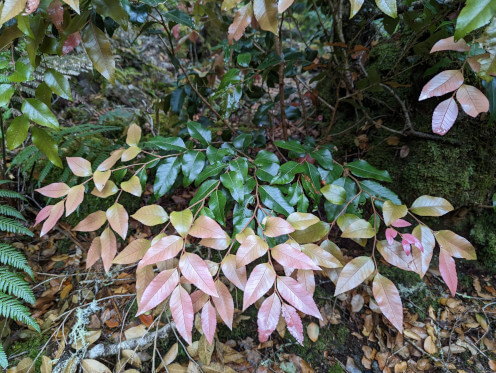
For the team at the Research Centre for Ecosystem Resilience (ReCER), a request from the Blue Mountains Botanic Garden to design a hedge of the towering Nothofagus moorei, or Antarctic beech, sparked a unique collaboration between science and horticulture.
In the lower Hunter Valley, a new nature reserve named Tiraki – Wonnarua for ironbark – has become a sanctuary for one of Australia’s rarest plants.
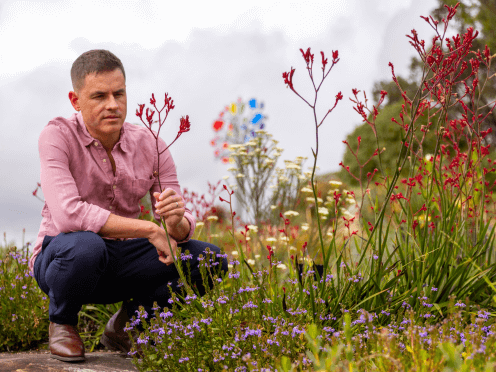
In this new episode of What the Flora!? discover why this world-first global ‘Tree of Life’ study is a new milestone in understanding the evolutionary history of flowering plants.